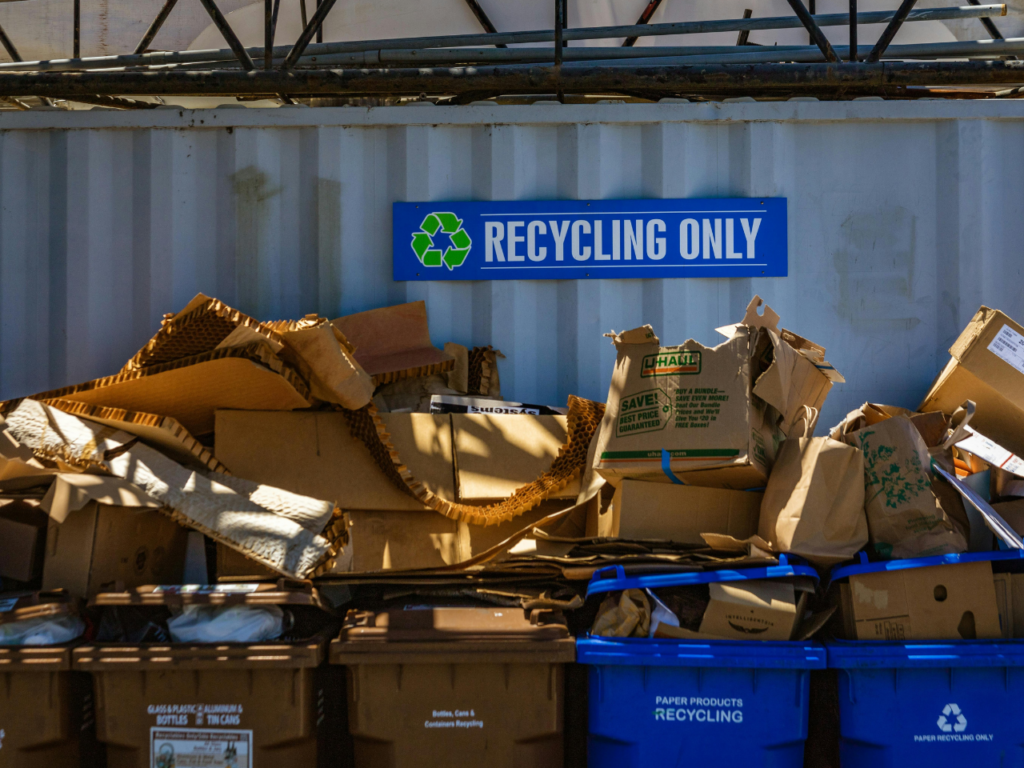The general perception of waste has changed over the past few years. With reuse preferred before recycling, people are becoming more responsible with their waste. As society becomes increasingly tech-driven, the rise in e-waste presents a growing challenge that demands urgent attention.
Growing e-waste volumes have led South Africa to introduce new legislation, the Waste Act was updated in November 2024 to clarify and streamline the Extended Producer Responsibility Regulations (EPR), which places the responsibility of an identified product’s life cycle on the obligated company defined in the regulations as a producer, rather than the consumer. Patricia Schröder, CEO of Circular Energy, a Producer Responsibility Organisation (PRO), spoke with Resource about e-waste and these new laws.
What is the difference between e-waste and ‘regular’ waste? How are they treated differently?

Patricia Schröder, CEO of Circular Energy
Patricia: The main difference between e-waste and regular waste is composition, environmental impact, and the challenge of managing e-waste properly. E-waste, which is classified as hazardous waste in the South African waste classification regulations, includes discarded electronics containing hazardous and toxic materials like heavy metals, which cannot be treated the same way as regular waste – which is non-hazardous. E-waste poses a greater risk to the environment due to the potential for toxic materials that can leach into the soil and water. It is because of this that e-waste must be handled differently than regular waste by people who know how to manage it. E-waste and battery waste is restricted to landfill and requires specialised recycling processes to ensure the toxic components are recovered safely and in accordance with best environmental practices.
Could you explain some of the damage caused by throwing away something innocuous, such as a battery?

If recycled properly e-waste becomes a valuable resource.
While ‘e-waste’ is a relatively new term, society has been dealing with it for a long time. Throwing batteries away with regular waste can have a significant impact on the environment. Batteries that end up in landfills can leak toxic materials like lead, cadmium, or lithium. These leaching materials can cause long-term soil degradation and severe water pollution, affecting plants, animals, and drinking water supplies. Batteries that end up in a landfill that uses incineration will release harmful chemicals into the air if no flue gas scrubbing is present, once they are incinerated. This impacts air quality and can be linked to respiratory problems in nearby communities. Additionally, certain battery chemistries are also a fire hazard in landfills. When battery waste is not disposed of properly, it results inlost resources. Batteries can contain valuable materials that can be recovered, such as metals and electrolytes. Disposing of them as regular waste means losing these resources and increasing the demand for new raw materials.
What is the scale of the e-waste problem in South Africa?
- It is significant and growing, with serious implications for the environment and public health. Volume: As of August 2021, the South African government restricted e-waste and batteries from landfills, encouraging citizens to recycle instead. The Department of Forestry, Fisheries, and the Environment estimates that South Africa generates an annual average of 360 000 tonnes of e-waste. This accounts for 5% to 8% of the country’s municipal solid waste and is growing three times faster than any other waste stream.
- The Western Cape alone produced between 43 290 and 68 501 tonnes of e-waste in 2020.
- Collection rates: Only a small percentage of e-waste (around 10 to 15%) is properly collected and recycled, leading to a large amount of waste ending up in landfills or being informally disposed of.
- Informal sector: A significant portion of e-waste is handled by the informal sector, where workers often lack the necessary skills to manage the waste properly and protective gear, resulting in exposure to hazardous and toxic materials, increasing health risks.
What is the impact of the Extended Producer Responsibility (EPR) laws?
EPR laws shift the responsibility for managing e-waste from consumers and municipal integration to manufacturers, brand owners and importers, defined as producers in the regulations. This means that companies are now required to take back their products at the end of their lifecycle, ensuring they are recycled or disposed of responsibly. This encourages manufacturers to design products that are easier to recycle and to minimise hazardous or toxic materials in their products. The main goals of EPR laws are to increase the lifespan of products, reduce the amount of e-waste, increase recycling rates, and protect the environment.

These laws encourage better product design with longer lifespans to reduce the volume of e-waste generated. The e-waste that is generated is recycled at a higher rate and valuable materials are recovered to aid the circular economy.
This process minimises the environmental and health risks associated with improper disposal of hazardous and toxic materials in e-waste. EPR is transforming the waste sector by creating new business models, as companies develop new recycling and take-back programmes. These regulations also standardise practices in the sector to ensure that there is a uniform approach across different industries and regions. Overall, EPR laws aim to create a more sustainable system for managing e-waste, benefiting the environment, and encouraging responsible production and consumption.
What is a PRO, what do they do?

EPR laws enhance cooperation between governments and businesses facilitated by PROs.
The biggest change these EPR laws have is that they encourage collaboration between various stakeholders such as inter alia importers, manufacturers, recyclers, and governments. Producer Responsibility Organisations (PROs) facilitate the cooperation between these entities and foster a more integrated approach to waste management. A PRO is a not for profit entity that assists producers to comply with the EPR regulatory requirements and targets through various key stakeholders within the country. As a PRO, Circular Energy appoints its accredited recyclers and transporters for the collection and recycling of identified products to meet the set annual targets, in addition to other regulatory requirements such as inter alia compliance management, informal sector and municipal integration, awareness and education campaigns, data management, DFFE reporting, and strategic partnerships. Collection, or access to the waste is the backbone of the recycling process, and as a PRO, we manage the collection, transport, recovery, recycling, and proper disposal of e-waste on behalf of producers. We also set up drop-off points and collection events to make it easier for consumers to recycle their electrical equipment and electronic devices. Producers have a responsibility to ensure that the products they import or locally manufacture to sell, and the packaging they use are recycled and diverted from landfills as much as possible. We help them navigate the laws and compliance to ensure they are meeting the legal requirements of the EPR regulations as well as getting the benefits of their efforts. PROs like Circular Energy have a duty to educate the public and we engage in public education campaigns to inform consumers about proper e-waste disposal methods and the importance of recycling. E-waste is logistically complex, and we track and report on data that is related to e-waste management, helping producers understand their impact and facilitating compliance with regulatory requirements. Our role as a PRO also means that we collaborate with local governments, recycling facilities, and other stakeholders to develop effective waste management strategies.
How can individuals, businesses, and communities get involved and make a difference?

One of the ultimate goals of the EPR regulations is to divert waste from landfills as much as possible, an environmental win as e-waste can become leachate which pollutes water and soil
Individuals, businesses, and communities can all play a significant role in promoting e-waste recycling and responsible disposal.
Individuals
- Proper disposal: Always recycle electrical equipment and electronic devices through designated e-waste collection points rather than throwing them in the trash.
- Educate yourself and others: Learn about the impacts of e-waste and share this information with friends and family to raise awareness.
- Participate in events: Attend local e-waste collection drives or workshops to contribute to recycling efforts.
- Choose sustainable products: Opt for electronics from companies that prioritise sustainability and offer take-back programs.
Businesses
- Implement e-waste policies: Establish clear policies for the proper disposal and recycling of electrical and electronic equipment within the organisation.
- Partner with PROs to facilitate e-waste collection and recycling.
- Educate employees: Provide training on responsible e-waste disposal and encourage staff to participate in recycling initiatives.
- Offer take-back programmes: Create programmes for customers to return old electrical and electronic equipment when purchasing new products.
Communities
- Organise collection events: Local groups can host e-waste collection days to encourage residents to recycle their old electrical and electronic equipment.
- Raise awareness: Use community newsletters, social media, and local events to inform residents about the importance of e-waste recycling.
- Support local initiatives: Get involved with or support local organisations working on e-waste management and sustainability.
- Advocate for policies: Engage with local governments to promote policies that support e-waste recycling and responsible disposal.
Waste management has always been collaborative, and e-waste is no different. Involving yourself as an individual, business, or community raises awareness and aids in the control of the growing e-waste problem.










